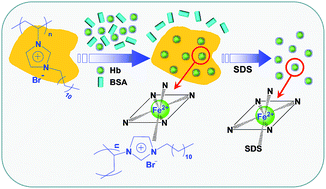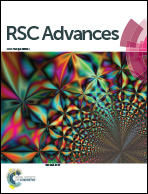Ionic liquid poly(3-n-dodecyl-1-vinylimidazolium) bromide as an adsorbent for the sorption of hemoglobin†
Abstract
A novel polymeric ionic liquid, poly(3-n-dodecyl-1-vinylimidazolium) bromide (poly(C12vim)Br), is prepared via solution polymerization. The poly(C12vim)Br exhibits excellent adsorption performance toward hemoglobin in the presence of other protein species. It is shown that favorable adsorption of hemoglobin is achieved at pH 8.0, and the variation of ionic strength has virtually no effect on the adsorption of hemoglobin at a NaCl concentration up to 0.4 mol L−1. A maximum adsorption capacity of 205.4 mg g−1 is derived for hemoglobin. An adsorption efficiency of 93.8% is obtained by processing 80 μg mL−1 of hemoglobin in 1.0 mL of solution with 2 mg of poly(C12vim)Br, and afterwards the use of 1.0 mL of sodium dodecyl sulfate (SDS, 0.5%, m/v) provides a recovery of ca. 86.3%. It is indicated that the process of adsorption/desorption causes a slight conformational change for hemoglobin, while its structure remains predominantly α-helix. The poly(C12vim)Br has been used for the adsorption of hemoglobin from complex biological sample matrixes, e.g., human whole blood, and the favorable separation and purification performance is demonstrated by SDS-PAGE assays.


 Please wait while we load your content...
Please wait while we load your content...